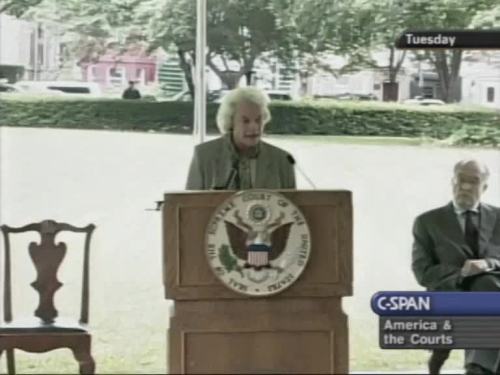By Justice Sandra Day O'Connor
Speech at groundbreaking ceremony for the modernization of the Supreme Court building
June 17, 2003

DISCLAIMER: This text has been transcribed automatically and may contain substantial inaccuracies due to the limitations of automatic transcription technology. This transcript is intended only to make the content of this document more easily discoverable and searchable. If you would like to quote the exact text of this document in any piece of work or research, please view the original using the link above and gather your quote directly from the source. The Sandra Day O'Connor Institute does not warrant, represent, or guarantee in any way that the text below is accurate.
Transcript
(Automatically generated)
William Rehnquist
Good afternoon.
It's my pleasure to welcome you to the groundbreaking ceremony for the modernization of the Supreme Court building 72 years ago in the spring of 1931, the work of digging the foundation for our beautiful building began. Four years later, on April 4 1935, the building was completed. The total cost, including furnishings was less than $10 million. And it came in under budget, with almost $100,000 returned to the Treasury. The runner vision project for which we break ground today is scheduled to take five years, and it cost 120 $2 million. when it's completed, I hope that we will again be returning funds to the Treasury, but I'm not betting on it. William Howard Taft, who served as Chief Justice from 1921 to 1930, was the moving force behind constructing a separate building for the court. Although he did not live long enough to see it completed. Until this building open, the court did not have a home of its own. From 1800 and one until 1935. It occupied cramped quarters across the street in the capital, very much at the sufferance of Congress. And most justices worked out of their homes. having its own building was a great symbolic importance to the court. The building has been Captain excellent repair, and looks as beautiful today as when I first saw it, February of 1952. But after nearly 70 years, it's overdue for renovation. I would like to thank the members of the courts building committee, particularly Justice O'Connor, who chairs the committee, I know the committee members have all worked hard to make sure that this resident renovation is done right, and is completed on schedule and within the budget. I would also like to thank the architect of the capital, Alan Hanneman and his staff who have been assigned to this project for all their hard work. Before we begin digging, Justice O'Connor will make brief remarks.
Sandra Day O'Connor [automatically transcribed, may contain inaccuracies]
Thank you, Chief Justice. This project really began with studies that were made about six years ago, it's taken this long to reach the point of breaking ground for the actual work. And thinking about the project the court has been around about as long as I had. The difference is that with a building, when it gets that age, one can change all the infrastructure and keep it going for another 70 years or so. I wish that were possible for individuals as well, but it isn't. And this is the most beautiful building. It makes all of us proud and happy to walk into it every single day. And it's going to take until about 2008 to complete the work of changing the plumbing and the heating and cooling and the wiring Umma tell telephone lines and electrical system and so on all of the infrastructure even though we hope at the end of the day, it will be absolutely as lovely as it is now. And to do this takes quite a team of people. Allen hammam, the architect of the capital, who's here, and Michael Turner involved the assistant architect have worked very closely with George Karmanos and Harry Stanger, the project architects from your firm. And with Joseph flooring and john Varian, the project engineers from Loring associates, and Karen van Langan, who chairs the architecture school at the University of Virginia has consulted with us and been a great help to the building committee. We now have on board can champion our project manager from Hill International, who's a recent but wonderful addition to this team effort. And I want especially to thank the members of the courts building committee, especially Justice Kennedy and Justice Souter, who couldn't be with us today. And we owe thanks as well, to the members of Congress who've made the funding available to modernize the building. It really is a group effort. We thank all of you. Now. Let's dig.
